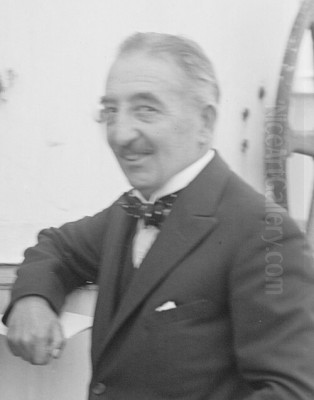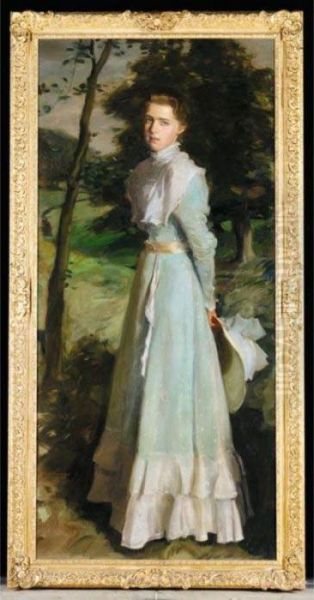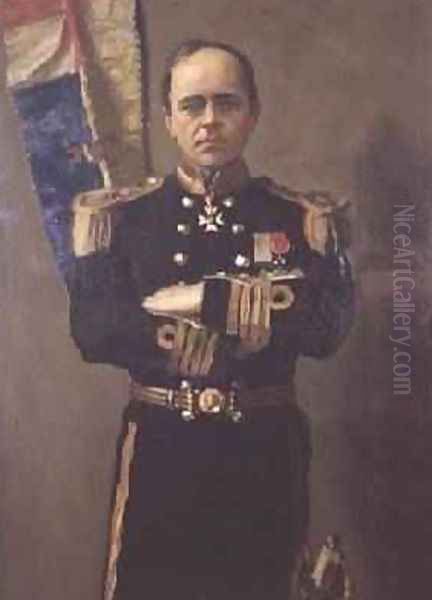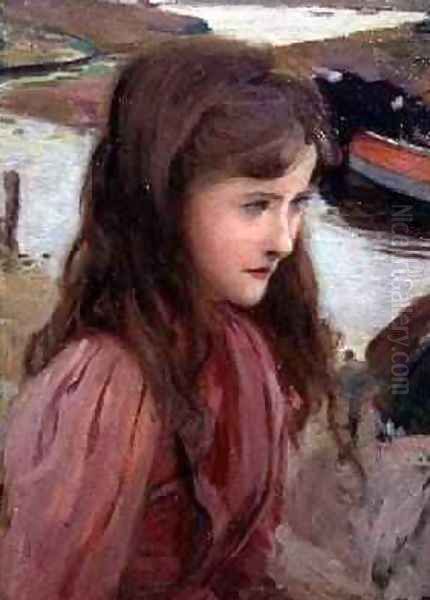
Harrington Mann (1864-1937) was a distinguished Scottish painter, primarily celebrated for his elegant portraiture that found favour on both sides of the Atlantic. Born in Glasgow, his artistic journey took him through key European art centres, shaping a style that blended traditional draftsmanship with modern sensibilities. His career spanned a period of significant change in the art world, and he navigated these shifts to become a sought-after artist, particularly for depictions of high society, while also contributing significantly to the theory of portrait painting.
Early Life and Artistic Formation
Harrington Mann's artistic education began in his native Glasgow at the Glasgow School of Art. However, reports suggest he developed an aversion to the drawing classes there, prompting a move to London. He enrolled at the prestigious Slade School of Fine Art, where he studied under the influential French-born artist Alphonse Legros. This move marked a significant step in broadening his artistic horizons beyond Scotland.
Seeking further refinement and exposure to continental trends, Mann travelled to Paris. There, he continued his studies at the renowned Académie Julian, a popular destination for international art students. His teachers in Paris included prominent figures of the French academic tradition, Gustave Boulanger and Jules Joseph Lefebvre. This comprehensive training provided Mann with a strong technical foundation, grounding him in classical methods while exposing him to the vibrant Parisian art scene where Impressionism and Post-Impressionism were unfolding.
Connection with The Glasgow Boys
During his formative years, Mann became associated with the "Glasgow Boys," a group of radical young Scottish painters active primarily in the 1880s and 1890s. This group reacted against the perceived conservatism of the Scottish art establishment and the sentimental nature of much contemporary painting. They embraced influences from French Realism, the Barbizon School, Naturalism, and the tonal experiments of James McNeill Whistler.

The Glasgow Boys, including key figures like James Guthrie, John Lavery, George Henry, and E.A. Walton, often worked outdoors (en plein air), favouring contemporary rural subjects and experimenting with bold brushwork and colour harmonies. While Mann is often described as being on the periphery of the core group, his early work, particularly his landscape painting, shared their interest in capturing the realities of modern rural life and the effects of natural light. This association undoubtedly influenced his early development, instilling an appreciation for direct observation and a more modern approach to paint handling, even as he later specialized in portraiture.
Rise to Prominence: A Master of Portraiture
By the mid-1890s, Harrington Mann had established himself as a highly successful portrait painter. His skill in capturing a likeness, combined with an elegant and sophisticated style, appealed greatly to the upper echelons of society in Britain. He possessed a talent for rendering not just the physical features of his sitters, but also conveying a sense of their personality and social standing.
His success was not confined to the United Kingdom. Mann recognized the opportunities presented by the burgeoning art market and wealthy patronage in the United States. He established studios in both London and New York City, effectively becoming a transatlantic artist. This dual presence allowed him to cater to an elite clientele on both continents, painting prominent figures, society ladies, and children with considerable flair. His sitters included members of the British Royal Family, cementing his status as a leading portraitist of his era.
Artistic Philosophy and Technique
Mann's mature style represented a skillful synthesis of his diverse training and influences. He remained grounded in the principles of naturalism and visual accuracy learned through his academic training, ensuring his portraits possessed a convincing likeness. However, he incorporated elements associated with Impressionism, particularly in his handling of light and colour, and often employed a freer, more fluid brushwork than strictly academic painters.
He developed a concept he termed the "Big View" versus the "Close Look." The "Big View" involved observing the subject from a distance to grasp the overall impression, the general masses of form and colour, and the essential character. The "Close Look," conversely, involved moving nearer to focus on specific details and refine particular features. This methodical approach allowed him to balance overall effect with necessary detail. Mann believed that while accurate observation of nature was crucial, the artist's imagination and interpretation were essential to elevate a painting beyond mere photographic representation. His ability to blend French stylistic freedom with a degree of detail appreciated by British and American patrons was key to his success.
Beyond Portraiture: Landscapes and Decorative Work

While portraiture formed the core of his professional output and reputation, Harrington Mann did not entirely abandon other genres. He continued to paint landscapes, showing a particular fondness for the coastal scenery of Yorkshire. His depictions of fishing villages in this region allowed him to explore themes of rural life and atmospheric effects, likely harking back to his earlier interests shared with the Glasgow Boys.
Furthermore, Mann demonstrated his versatility by undertaking decorative commissions. Records indicate he designed stained glass for a company in Italy and created decorative panels for a girls' school in Dunbartonshire, Scotland. These projects suggest a broader artistic engagement beyond the confines of easel painting, showcasing his ability to adapt his skills to different mediums and contexts.
The Technique of Portrait Painting
Perhaps one of Harrington Mann's most enduring contributions, beyond his painted works, was his influential book, The Technique of Portrait Painting: A complete & helpful guide to the composition, lighting & painting of portraits in oils. Published in 1933, relatively late in his career, this treatise distilled his extensive experience and insights into a practical guide for aspiring and established artists.
The book delves into crucial aspects of portraiture, including composition, the effective use of lighting to model form and create mood, colour theory, paint application, and capturing a likeness. It articulated his methodical approach, including the "Big View" and "Close Look" concepts. The publication was well-received and became a valuable resource, influencing subsequent generations of portrait painters. Some commentators suggest that this book helped secure Mann's place in art history, ensuring his name would be remembered not just for his canvases but also for his thoughtful contribution to artistic pedagogy.
Notable Works and Recognition
Harrington Mann's oeuvre includes numerous portraits that exemplify his style. Among his celebrated works are Mona and Kathleen (a sensitive portrayal of two girls), Mrs. Spencer Nairne, Miss Mary Nairne, and Lady Maud Warrender. These paintings showcase his skill in capturing the textures of fabrics, the play of light on his subjects, and a sense of refined elegance.
His portrait of the Antarctic explorer Robert Falcon Scott was commissioned for the Royal Geographical Society, indicating the high regard in which his work was held. Another painting, A Young Girl, achieved significant recognition in the art market when it set a personal auction record for the artist, selling for £68,000 at a Dreweatts auction. This particular work had previously hung in the family home of the renowned designer Anouska Hempel. Such results underscore the continued appreciation for Mann's artistry.
Family and Legacy

Artistic talent ran in the Mann family. His daughter, Cathleen Sabine Mann (1896–1959), followed in his footsteps to become a notable artist in her own right, known for her portraits and drawings. She further connected the family to aristocratic circles through her marriage, becoming the Marchioness of Queensberry. Some sources also mention Mann's grandfather, James Mann, as having been associated with the Royal Academy, suggesting a longer familial connection to the art world.
Harrington Mann's legacy resides in his substantial body of work, particularly his society portraits, which offer a window into the elite world of the late 19th and early 20th centuries. His paintings are valued for their technical skill, elegance, and psychological insight. Furthermore, his book, The Technique of Portrait Painting, remains a testament to his thoughtful approach to his craft and continues to be a valuable reference.
Market Presence and Collections
Harrington Mann's works continue to appear on the art market, featuring in auctions in the UK and internationally, as evidenced by the Dreweatts sale and mentions of his work in Hempel collection sales. This indicates a sustained interest among collectors.
Beyond the private market, his paintings are held in permanent public collections. While specific museum names were not detailed in the initial source material, it is known that his work, particularly portraits of significant figures like Robert Falcon Scott (held by the Royal Geographical Society), can be found in institutional settings in Britain and potentially other countries where he worked or where his patrons resided. His international career ensured his work reached a wide audience and found homes in various collections.
Mann in Context: Contemporaries
Harrington Mann practiced during a dynamic period in art history, bridging the late Victorian era, the Edwardian period, and the early 20th century. He was a contemporary of many significant artists, both in Britain and internationally. Understanding his work benefits from considering it alongside that of his peers:
John Singer Sargent (1856-1925): Perhaps the most direct comparison, Sargent was another hugely successful transatlantic portraitist, also trained in Paris, known for his dazzling brushwork and insightful characterizations. Both catered to a similar elite clientele.
James McNeill Whistler (1834-1903): An American expatriate influential in London, Whistler's aestheticism and tonal harmonies impacted many artists, including the Glasgow Boys. His approach to portraiture offered a distinct alternative to academic realism.
The Glasgow Boys: As mentioned, James Guthrie (1859-1930), John Lavery (1856-1941), George Henry (1858-1943), and E.A. Walton (1860-1922) were key figures whose early concerns with realism and plein air painting Mann shared to some extent. Lavery also became a highly successful society portraitist.
Philip de László (1869-1937): A Hungarian-born artist who became a dominant figure in British society portraiture, known for his sophisticated and often flattering depictions of European royalty and aristocracy. A direct competitor in the field.
William Orpen (1878-1931): An Irish painter who achieved great success in London as a portraitist, known for his vigorous style and insightful, sometimes unsparing, depictions.
Charles Hopkinson (1869-1962): An American contemporary, particularly noted for his portraits within the Boston art scene and beyond.
Leopold Seyffert (1887-1956): Another American portrait painter active during the later part of Mann's career.
Archibald Standish Hartrick (1864-1950): A British painter and lithographer, an exact contemporary by birth year, associated with the New English Art Club.
Alphonse Legros (1837-1911): Mann's teacher at the Slade, Legros was himself a significant painter and etcher, representing a link to French realism and traditional draftsmanship.
Gustave Boulanger (1824-1888) & Jules Joseph Lefebvre (1836-1911): Mann's Parisian teachers represented the established French academic tradition against which many modern movements were reacting, yet provided technical grounding for countless artists.
Mann navigated this complex landscape, absorbing lessons from academic training, acknowledging the innovations of Impressionism and the Glasgow School, and ultimately forging a successful career by meeting the demands of the lucrative market for society portraiture with skill and elegance.
Conclusion
Harrington Mann stands as a significant figure in British and American art from the late 19th to the early 20th century. His journey from Glasgow through the art schools of London and Paris equipped him with the skills to become a leading society portraitist on both sides of the Atlantic. While associated with the progressive Glasgow Boys in his youth, he carved his niche in the more traditional, yet highly demanding, field of portraiture, adapting modern painterly techniques to create works of enduring elegance. His legacy is twofold: a collection of finely executed portraits that capture an era, and an influential treatise on technique that demonstrates his thoughtful mastery of the craft. He remains an artist whose work reflects both the artistic currents and the social fabric of his time.